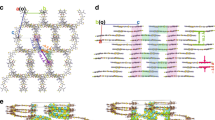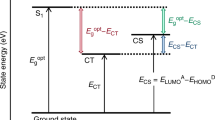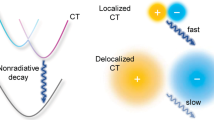Abstract
Organic solar cells (OSCs) utilizing π-conjugated polymers have attracted widespread interest over the past three decades because of their potential advantages, including low weight, thin film flexibility, and low-cost manufacturing. However, their power conversion efficiency (PCE) has been far below that of inorganic analogs. Geminate recombination of charge transfer excitons is a major loss process in OSCs. This paper reviews our recent progress in using transient absorption spectroscopy to understand geminate recombination in bulk heterojunction OSCs, including the impact of polymer crystallinity on charge generation and dissociation mechanisms in nonfullerene acceptor-based OSCs. The first example of a high PCE with a small photon energy loss is also presented. The importance of delocalization of the charge wave function to suppress geminate recombination is highlighted by this focus review.
This is a preview of subscription content, access via your institution
Access options
Subscribe to this journal
Receive 12 print issues and online access
$259.00 per year
only $21.58 per issue
Buy this article
- Purchase on Springer Link
- Instant access to full article PDF
Prices may be subject to local taxes which are calculated during checkout







Similar content being viewed by others
References
Clarke TM, Durrant JR. Charge photogeneration in organic solar cells. Chem Rev. 2010;110:6736–67.
Lu L, Zheng T, Wu Q, Schneider AM, Zhao D, Yu L. Recent advances in bulk heterojunction polymer solar cells. Chem Rev. 2015;115:12666–731.
Inganäs O. Organic photovoltaics over three decades. Adv Mater. 2018;30:1800388.
Hou J, Inganäs O, Friend RH, Gao F. Organic solar cells based on non-fullerene acceptors. Nat Mater. 2018;17:119–28.
Guo JM, Ohkita H, Benten H, Ito S. Charge generation and recombination dynamics in poly(3-hexylthiophene)/fullerene blend films with different regioregularities and morphologies. J Am Chem Soc. 2010;132:6154–64.
Halls JJM, Walsh CA, Greenham NC, Marseglia EA, Friend RH, Moratti SC, et al. Efficient photodiodes from interpenetrating polymer networks. Nature. 1995;376:498–500.
Zhan C, Zhang X, Yao J. New advances in non-fullerene acceptor based organic solar cells. RSC Adv. 2015;5:93002–26.
McAfee SM, Topple JM, Hill IG, Welch GC. Key components to the recent performance increases of solution processed non-fullerene small molecule acceptors. J Mater Chem A. 2015;3:16393–408.
McNeill CR, Westenhoff S, Groves C, Friend RH, Greenham NC. Influence of nanoscale phase separation on the charge generation dynamics and photovoltaic performance of conjugated polymer blends: balancing charge generation and separation. J Phys Chem C. 2007;111:19153–60.
Westenhoff S, Howard IA, Hodgkiss JM, Kirov KR, Bronstein HA, Williams CK, et al. Charge recombination in organic photovoltaic devices with high open-circuit voltages. J Am Chem Soc. 2008;130:13653–8.
Hodgkiss JM, Campbell AR, Marsh RA, Rao A, Albert-Seifried S, Friend RH. Subnanosecond geminate charge recombination in polymer-polymer photovoltaic devices. Phys Rev Lett. 2010;104:177701.
Moore JR, Albert-Seifried S, Rao A, Massip S, Watts B, Morgan DJ, et al. Polymer blend solar cells based on a high-mobility naphthalenediimide-based polymer acceptor: device physics, photophysics and morphology. Adv Energy Mater. 2011;1:230–40.
Schubert M, Collins BA, Mangold H, Howard IA, Schindler W, Vandewal K, et al. Correlated donor/acceptor crystal orientation controls photocurrent generation in all-polymer solar cells. Adv Funct Mater. 2014;24:4068–81.
Gehrig DW, Roland S, Howard IA, Kamm V, Mangold H, Neher D, et al. Efficiency-limiting processes in low-bandgap polymer:perylene diimide photovoltaic blends. J Phys Chem C. 2014;118:20077–85.
Zhang GY, Zhao JB, Chow PCY, Jiang K, Zhang JQ, Zhu ZL, et al. Nonfullerene acceptor molecules for bulk heterojunction organic solar cells. Chem Rev. 2018;118:3447–507.
Wadsworth A, Moser M, Marks A, Little MS, Gasparini N, Brabec CJ, et al. Critical review of the molecular design progress in non-fullerene electron acceptors towards commercially viable organic solar cells. Chem Soc Rev. 2019;48:1596–625.
Yuan J, Zhang YQ, Zhou LY, Zhang GC, Yip HL, Lau TK, et al. Single-junction organic solar cell with over 15% efficiency using fused-ring acceptor with electron-deficient core. Joule. 2019;3:1140–51.
Lin YB, Adilbekova B, Firdaus Y, Yengel E, Faber H, Sajjad M, et al. 17% efficient organic solar cells based on liquid exfoliated WS2 as a replacement for PEDOT:PSS. Adv Mater. 2019;31:9.
Cui Y, Yao HF, Zhang JQ, Zhang T, Wang YM, Hong L, et al. Over 16% efficiency organic photovoltaic cells enabled by a chlorinated acceptor with increased open-circuit voltages. Nat Commun. 2019;10:8.
Menke SM, Ran NA, Bazan GC, Friend RH. Understanding energy loss in organic solar cells: toward a new efficiency regime. Joule. 2018;2:25–35.
Li WW, Hendriks KH, Furlan A, Wienk MM, Janssen RAJ. High quantum efficiencies in polymer solar cells at energy losses below 0.6 eV. J Am Chem Soc. 2015;137:2231–4.
Tamai Y, Ohkita H, Shimada J, Benten H, Ito S, Yamanaka S, et al. Dynamical excimer formation in rigid carbazolophane via charge transfer state. J Phys Chem A. 2013;117:7776–85.
Tamai Y, Ohkita H, Benten H, Ito S. Singlet fission in poly(9,9′-di-n-octylfluorene) films. J Phys Chem C. 2013;117:10277–84.
Tamai Y, Tsuda K, Ohkita H, Benten H, Ito S. Charge-carrier generation in organic solar cells using crystalline donor polymers. Phys Chem Chem Phys. 2014;16:20338–46.
Tamai Y, Ohkita H, Benten H, Ito S. Triplet exciton dynamics in fluorene-amine copolymer films. Chem Mater. 2014;26:2733–42.
Tamai Y, Matsuura Y, Ohkita H, Benten H, Ito S. One-dimensional singlet exciton diffusion in poly(3-hexylthiophene) crystalline domains. J Phys Chem Lett. 2014;5:399–403.
Tamai Y, Ohkita H, Benten H, Ito S. Exciton diffusion in conjugated polymers: from fundamental understanding to improvement in photovoltaic conversion efficiency. J Phys Chem Lett. 2015;6:3417–28.
Kawashima K, Tamai Y, Ohkita H, Osaka I, Takimiya K. High-efficiency polymer solar cells with small photon energy loss. Nat Commun. 2015;6:10085.
Kasai Y, Tamai Y, Ohkita H, Benten H, Ito S. Ultrafast singlet fission in a push-pull low-bandgap polymer film. J Am Chem Soc. 2015;137:15980–3.
Tamai Y, Ohkita H, Namatame M, Marumoto K, Shimomura S, Yamanari T, et al. Light-induced degradation mechanism in poly(3-hexylthiophene)/fullerene blend solar cells. Adv Energy Mater. 2016;6:1600171.
Tamai Y, Fan Y, Kim VO, Ziabrev K, Rao A, Barlow S, et al. Ultrafast long-range charge separation in nonfullerene organic solar cells. ACS Nano. 2017;11:12473–81.
Umeyama T, Igarashi K, Sasada D, Tamai Y, Ishida K, Koganezawa T, et al. Efficient light-harvesting, energy migration, and charge transfer by nanographene-based nonfullerene small-molecule acceptors exhibiting unusually long excited-state lifetime in the film state. Chem Sci. 2020;11:3250–7.
Mauer R, Howard IA, Laquai F. Effect of nongeminate recombination on fill factor in polythiophene/methanofullerene organic solar cells. J Phys Chem Lett. 2010;1:3500–5.
Howard IA, Mauer R, Meister M, Laquai F. Effect of morphology on ultrafast free carrier generation in polythiophene:fullerene organic solar cells. J Am Chem Soc. 2010;132:14866–76.
Shoaee S, Subramaniyan S, Xin H, Keiderling C, Tuladhar PS, Jamieson F, et al. Charge photogeneration for a series of thiazolo-thiazole donor polymers blended with the fullerene electron acceptors PCBM and ICBA. Adv Funct Mater. 2013;23:3286–98.
Gélinas S, Rao A, Kumar A, Smith SL, Chin AW, Clark J, et al. Ultrafast long-range charge separation in organic semiconductor photovoltaic diodes. Science. 2014;343:512–6.
Dimitrov SD, Durrant JR. Materials design considerations for charge generation in organic solar cells. Chem Mater. 2014;26:616–30.
Etzold F, Howard IA, Forler N, Cho DM, Meister M, Mangold H, et al. The effect of solvent additives on morphology and excited-state dynamics in PCPDTBT:PCBM photovoltaic blends. J Am Chem Soc. 2012;134:10569–83.
Motaung DE, Malgas GF, Arendse CJ. Correlation between the morphology and photo-physical properties of P3HT:Fullerene blends. J Mater Sci. 2010;45:3276–83.
Salleo A, Kline RJ, DeLongchamp DM, Chabinyc ML. Microstructural characterization and charge transport in thin films of conjugated polymers. Adv Mater. 2010;22:3812–38.
Chen H-Y, Hou J, Hayden AE, Yang H, Houk KN, Yang Y. Silicon atom substitution enhances interchain packing in a thiophene-based polymer system. Adv Mater. 2010;22:371–5.
Chen D, Nakahara A, Wei D, Nordlund D, Russell TP. P3HT/PCBM bulk heterojunction organic photovoltaics: correlating efficiency and morphology. Nano Lett. 2011;11:561–7.
Agostinelli T, Ferenczi TAM, Pires E, Foster S, Maurano A, Müller C, et al. The role of alkane dithiols in controlling polymer crystallization in small band gap polymer:fullerene solar cells. J Polym Sci B Polym Phys. 2011;49:717–24.
Yamamoto S, Ohkita H, Benten H, Ito S. Role of interfacial charge transfer state in charge generation and recombination in low-bandgap polymer solar cell. J Phys Chem C. 2012;116:14804–10.
Guilbert AAY, Frost JM, Agostinelli T, Pires E, Lilliu S, Macdonald JE, et al. Influence of bridging atom and side chains on the structure and crystallinity of cyclopentadithiophene–benzothiadiazole polymers. Chem Mater. 2014;26:1226–33.
Mayer AC, Toney MF, Scully SR, Rivnay J, Brabec CJ, Scharber M, et al. Bimolecular crystals of fullerenes in conjugated polymers and the implications of molecular mixing for solar cells. Adv Funct Mater. 2009;19:1173–9.
Cates NC, Gysel R, Beiley Z, Miller CE, Toney MF, Heeney M, et al. Tuning the properties of polymer bulk heterojunction solar cells by adjusting fullerene size to control intercalation. Nano Lett. 2009;9:4153–7.
Hammond MR, Kline RJ, Herzing AA, Richter LJ, Germack DS, Ro H-W, et al. Molecular order in high-efficiency polymer/fullerene bulk heterojunction solar cells. ACS Nano. 2011;5:8248–57.
Liu F, Gu Y, Jung JW, Jo WH, Russell TP. On the morphology of polymer-based photovoltaics. J Polym Sci B Polym Phys. 2012;50:1018–44.
Sweetnam S, Graham KR, Ndjawa GON, Heumueller T, Bartelt JA, Burke TM, et al. Characterization of the polymer energy landscape in polymer:fullerene bulk heterojunctions with pure and mixed phases. J Am Chem Soc. 2014;136:14078–88.
Jamieson FC, Agostinelli T, Azimi H, Nelson J, Durrant JR. Field-independent charge photogeneration in PCPDTBT/PC70BM solar cells. J Phys Chem Lett. 2010;1:3306–10.
Ie Y, Morikawa K, Zajaczkowski W, Pisula W, Kotadiya NB, Wetzelaer G-JAH, et al. Enhanced photovoltaic performance of amorphous donor–acceptor copolymers based on fluorine-substituted benzodioxocyclohexene-annelated thiophene. Adv Energy Mater. 2018;8:1702506.
Shivanna R, Shoaee S, Dimitrov S, Kandappa SK, Rajaram S, Durrant JR, et al. Charge generation and transport in efficient organic bulk heterojunction solar cells with a perylene acceptor. Energy Environ Sci. 2014;7:435–41.
Rao A, Chow PC, Gélinas S, Schlenker CW, Li CZ, Yip HL, et al. The role of spin in the kinetic control of recombination in organic photovoltaics. Nature. 2013;500:435–9.
Chow PC, Gélinas S, Rao A, Friend RH. Quantitative bimolecular recombination in organic photovoltaics through triplet exciton formation. J Am Chem Soc. 2014;136:3424–9.
Gehrig DW, Howard IA, Laquai F. Charge carrier generation followed by triplet state formation, annihilation, and carrier recreation in PBDTTT-C/PC60BM photovoltaic blends. J Phys Chem C. 2015;119:13509–15.
Vohra V, Kawashima K, Kakara T, Koganezawa T, Osaka I, Takimiya K, et al. Efficient inverted polymer solar cells employing favourable molecular orientation. Nat Photonics. 2015;9:403–8.
Kawashima K, Osaka I, Takimiya K. Effect of chalcogen atom on the properties of naphthobischalcogenadiazole-based π-conjugated polymers. Chem Mater. 2015;27:6558–70.
Vandewal K, Tvingstedt K, Manca JV, Inganäs O. Charge-transfer states and upper limit of the open-circuit voltage in polymer:fullerene organic solar cells. IEEE J Sel Top Quantum Electron. 2010;16:1676–84.
Vandewal K, Tvingstedt K, Gadisa A, Inganäs O, Manca JV. Relating the open-circuit voltage to interface molecular properties of donor: acceptor bulk heterojunction solar cells. Phys Rev B. 2010;81:125204.
Acknowledgements
The author thanks Prof Sir Richard Friend, Dr S. Matthew Menke, Prof Itaru Osaka, Prof Shinzaburo Ito, and Prof Hideo Ohkita for fruitful discussions. The author also thanks all other collaborators. This work was partly supported by JSPS Postdoctoral Fellowships for Research Abroad, JSPS KAKENHI Grant-in-Aid for Young Scientists (B) No. 17K14527, and JST PRESTO program Grant Number JPMJPR1874. The author also acknowledges financial support from Trycom Advance Co., Ltd.
Author information
Authors and Affiliations
Corresponding author
Ethics declarations
Conflict of interest
The authors declare that they have no conflict of interest.
Additional information
Publisher’s note Springer Nature remains neutral with regard to jurisdictional claims in published maps and institutional affiliations.
Rights and permissions
About this article
Cite this article
Tamai, Y. Delocalization boosts charge separation in organic solar cells. Polym J 52, 691–700 (2020). https://doi.org/10.1038/s41428-020-0339-4
Received:
Revised:
Accepted:
Published:
Issue Date:
DOI: https://doi.org/10.1038/s41428-020-0339-4
This article is cited by
-
Delocalization suppresses nonradiative charge recombination in polymer solar cells
Polymer Journal (2022)
-
Triplet sensitization via charge recombination at organic heterojunction for efficient near-infrared to visible solid-state photon upconversion
Communications Materials (2022)
-
Ultrafast charge generation in a homogenous polymer domain
Scientific Reports (2022)



